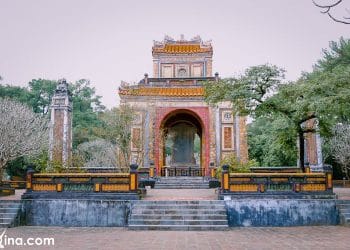1. History
Under the Nguyen Dynasty, the new Temple of Literature was constructed in the period of Gia Long King, and the old one was kept to worship Confucius’s parents. The construction work was completed in 1808, Gia Long King issued the principles and commanded to equip offering objects and alter old things. In the period of Minh Mang king, the court organized second-degree examinations, and then people started to build stelae of doctors. Over the years afterwards, the temple has experienced some original restoration works. In 1947, when France military invaded Hue and used it to build troops, they did damage to this monument.
2. Location
In Hue, the old capital in feudal periods of Vietnam, the Temple of Literature also called Van Mieu Hue, or Van Thanh Hue in Vietnamese language is situated in An Ninh Village, on the bank of Huong River, to the west of the Citadel. It is just about 1km far from prestigious Linh Mu pagoda.
3. Meaning

During the previous time, the Temples of Literature were constructed in the capital city by the Nguyen Lords and were moved to three different locations: Trieu Son Village, Luong Quang Village and Long Ho Village. However, Gia Long King settled this temple of Literature in on a fixed location until today. The Temple of Literature with the magnificent architecture is located on the riverside of Huong river. All the architecture lied on the three-meter hill compared to the ground, in front of the temple is Huong River, behind are villages, mountains. Hence, said to resemble to the terrain in the shape of the mountain and towards the river, Hue Temple of Literature shows a specific feature of countryside life and Vietnamese traditions. Also, the Huong River appears the contemplative beauty and contains the historical and cultural values when it is viewed from the temple of literature.
4. Sightseeing
Paying a visit to the monument of Hue Temple of Literature, tourists will have a chance to contemplate around 20 nearly undamaged architectural works with the unique ancient fine-art featuring Temple of Literature, Dai Thanh Sanctuary, Quan Duc Mon. Inside Tu Dai Thanh Mon, there is a place called Dai Thanh sanctuary to worship Confucianism for dedicating to his scholars. It is the primary structure of the temple. In front of the gate, there are four tall and massive brick pillars housed in Linh Tinh Mon near Huong riverside. The sign hung above is inscribed with four Chinese words “Dao Tai Luong Gian” (means “The principles of the world”) in the frontal side and “Trac Viet Thien Co” (means “Higher than ever before”) in the back side. In two areas of the gate, the stele “Khuynh cái hạ mã” is referred to as “tilt parasols, get off the horses”) .

Besides worshipping Confucianism, his four closest disciples Yanhui, Zengshen, Zisi and Mencius are also worshipped here. The Dai Thanh Sanctuary hosts altars to ten honoured philosophers. A small museum displays ink-well, pens, books, belonging to some of the students that studied at the temple.
At the front, there are two lines of 32 preserved steles bearing the names of 239 excellent candidates in National Examinations organized through the Nguyen Dynasty. Despite the damage of the monument during the war when the French military once used it as a barrack, the dominant part of the temple and especially the steles remain today.
Visiting the Temple of Literature, you have a chance to see a unique symbol of Vietnam education during the feudal periods in the Nguyen Dynasty. The construction of the temple or the placement of the doctors’ steles shows respect to the country’s talented people and invaluable traditions, culturally and educationally.
5. Transport
After going sightseeing Thien Mu Pagoda, visitors can spend more time coming to Hue temple of literature because it is also on the same road. Moreover, people can travel in a car or ride a motorbike or bike. Especially, admission is entirely free, and there is nearly no one who looks after the site.
Written By M. Phuong
Proofread by Hang Pham















